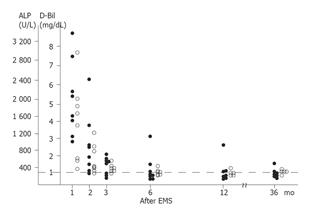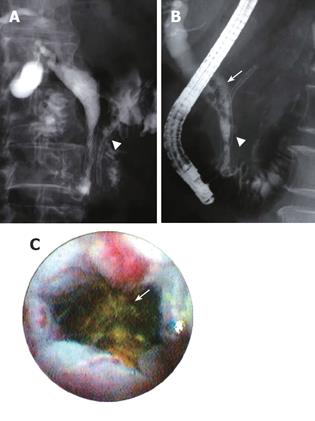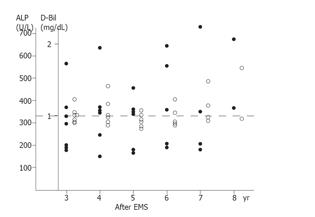Copyright
©2006 Baishideng Publishing Group Co.
World J Gastroenterol. Jan 21, 2006; 12(3): 426-430
Published online Jan 21, 2006. doi: 10.3748/wjg.v12.i3.426
Published online Jan 21, 2006. doi: 10.3748/wjg.v12.i3.426
Figure 1 Plotting of the serum alkaline phosphatase concentration (●) and conjugated bilirubin (○) of each patient during 3 yr after EMS.
The broken line indicates the upper limit of normal.
Figure 2 No bile duct stone was observed immediately after EMS in patient number 7 (A), however, stones were noted 6.
1 years later (arrow), and they were successfully removed using a basket wire (B). Peroral cholangioscopy revealed the common bile duct distal to the stone (arrow) was patent and the hyperplastic change was not conspicuous (C). Arrow head indicates the pancreatic duct stent.
Figure 3 Endoscopic view showing a duodenal ulcer on the side opposite to the duodenal papilla (A) 5.
9 years after the EMS in patient number 3. The stent had become dislodged and the steel wires protruded from the papilla (B). They were efficiently cut using the end-cutter (arrow) (C).
Figure 4 Plotting of the serum alkaline phosphatase concentration (●) and conjugated bilirubin (○) of each patient 3 yr after EMS.
The broken line indicates the upper limit of normal.
- Citation: Yamaguchi T, Ishihara T, Seza K, Nakagawa A, Sudo K, Tawada K, Kouzu T, Saisho H. Long-term outcome of endoscopic metallic stenting for benign biliary stenosis associated with chronic pancreatitis. World J Gastroenterol 2006; 12(3): 426-430
- URL: https://www.wjgnet.com/1007-9327/full/v12/i3/426.htm
- DOI: https://dx.doi.org/10.3748/wjg.v12.i3.426












